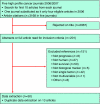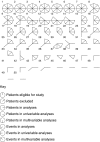Reporting of prognostic studies of tumour markers: a review of published articles in relation to REMARK guidelines
- PMID: 19997101
- PMCID: PMC2795163
- DOI: 10.1038/sj.bjc.6605462
Reporting of prognostic studies of tumour markers: a review of published articles in relation to REMARK guidelines
Abstract
Background: Poor reporting compromises the reliability and clinical value of prognostic tumour marker studies. We review articles to assess the reporting of patients and events using REMARK guidelines, at the time of guideline publication.
Methods: We sampled 50 prognostic tumour marker studies from higher impact cancer journals between 2006 and 2007. The inclusion criteria were cancer; focus on single biological tumour marker; survival analysis; multivariable analysis; and not gene array or proteomic data. Articles were assessed for the REMARK profile and other REMARK guideline items. We propose a reporting aid, the REMARK profile, motivated by the CONSORT flowchart.
Results: In 50 studies assessed for the REMARK profile, the number of eligible patients (56% of articles), excluded patients (54%) and patients in analyses (98%) was reported. Only 50% of articles reported the number of outcome events. In multivariable analyses, 54% and 30% of articles reported patient and event numbers for all variables. Of the studies, 66% used archival samples, indicating a potentially biased patient selection. Only 36% of studies reported clearly defined outcomes.
Conclusions: Good reporting is critical for the interpretability and clinical applicability of prognostic studies. Current reporting of key information, such as the number of outcome events in all patients and subgroups, is poor. Use of the REMARK profile would greatly improve reporting and enhance prognostic research.
Figures


References
-
- Altman DG (2006) Studies investigating prognostic factors: Conduct and evaluation. In Prognostic Factors in Cancer Gospodarowicz MK, O’Sullivan B, Sobin LH (eds) 3rd edn, pp 39–54. John Wiley & Sons: New York
-
- Altman DG (2007) Prognostic models: a methodological framework and review of models for breast cancer. In Breast cancer. Translational therapeutic strategies Lyman GH, Burstein HJ (eds) pp 11–25. Informa Healthcare: New York
-
- Altman DG, Lyman GH (1998) Methodological challenges in the evaluation of prognostic factors in breast cancer. Breast Cancer Res Treat 52: 289–303 - PubMed
-
- Altman DG, Riley RD (2005) Primer: an evidence-based approach to prognostic markers. Nat Clin Pract Oncol 2: 466–472 - PubMed
Publication types
MeSH terms
Substances
Grants and funding
LinkOut - more resources
Full Text Sources

